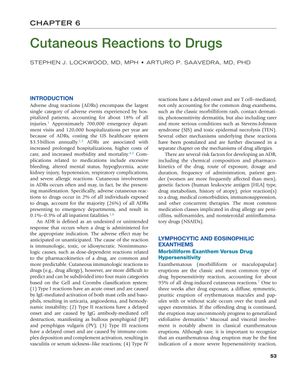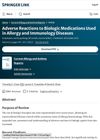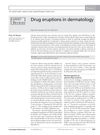Cutaneous Reactions to Drugs
July 2017
in “
Elsevier eBooks
”
cutaneous reactions adverse drug reactions Gell and Coombs classification immunologic cutaneous drug reactions exanthematous eruptions lichenoid eruptions Stevens-Johnson Syndrome Toxic Epidermal Necrolysis Sweet Syndrome urticaria angioedema vasculitic reactions DRESS allopurinol NSAIDs acantholytic disorders fixed drug eruptions acneiform eruptions pigmentary disorders nail disorders noncicatricial alopecia pruritus without rash SJS TEN

TLDR Skin reactions are a common reason for emergency visits due to drug allergies, with some severe cases needing intensive care.
The document from 2018 details the significant impact of adverse drug reactions (ADRs) on the U.S. healthcare system, with cutaneous reactions being a common manifestation and a major cause of emergency department visits. It outlines the Gell and Coombs classification of immunologic cutaneous drug reactions, risk factors for ADRs, and the most common medication classes causing drug allergies. Various types of drug-induced cutaneous reactions and their treatments are described, including exanthematous eruptions, lichenoid eruptions, and severe reactions like Stevens-Johnson Syndrome (SJS) and Toxic Epidermal Necrolysis (TEN). The document also discusses the management of other cutaneous reactions such as Sweet Syndrome, urticaria, angioedema, vasculitic reactions, and DRESS. SJS and TEN are highlighted as severe reactions with high mortality rates, triggered by medications like allopurinol and NSAIDs, and requiring immediate drug withdrawal and intensive care. Additionally, the document covers drug-induced acantholytic disorders, fixed drug eruptions, acneiform eruptions, pigmentary disorders, nail disorders, noncicatricial alopecia, and pruritus without rash, providing treatment protocols and emphasizing the importance of evaluating the benefits of continued drug therapy against the adverse effects on the skin.



